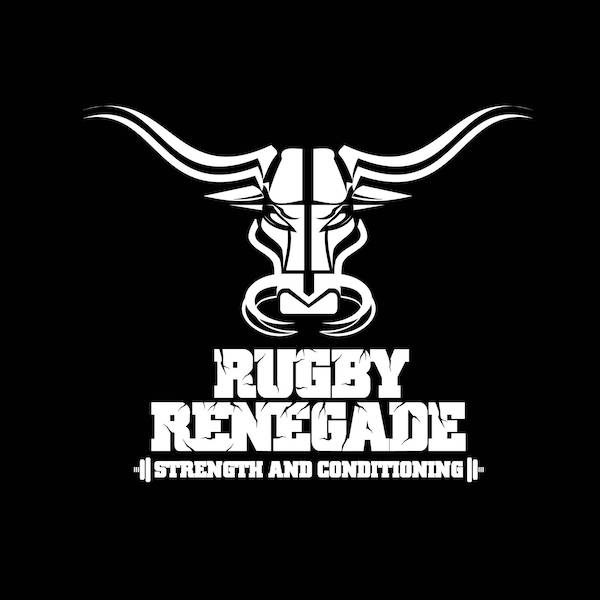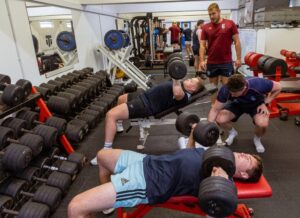First things first, BOX SQUATTING is not a SQUAT TO A BOX.
In this article we are going to discuss why rugby players should incorporate Box Squats into their programme….
We are advocates of Full Range of Motion Back/Front Squats but we also believe the Box Squat is an important exercise Rugby players should have in their toolbox.
Hopefully, once you have finished reading, you will understand the difference between Squatting to a Box and the Box Squat. Anyone can sit down on a box and stand back up, but you have to apply science and learn how to correctly execute the mechanics of the box squat in order to get the benefits.
During my professional rugby career, I spent many of those years, loading a bar up as heavy as possible and ‘Squatting to a Box’. The frustrating thing is I also spent a lot of that time suffering needlessly with my lower back. I now look back and understand the mistakes I made and hope with this article other players won’t suffer like I did.
So why should Players include Box Squats?
Box squatting builds greater absolute and explosive strength. Explosive strength is an absolute requirement for all rugby players. An exceptional rate of force development (RFD) means greater acceleration, giving you an edge over an opponent.
Box Squats are great for players In Season, when playing week in, week out, since they result in less soreness allowing for faster recovery between sessions.
It also teaches players to engage the Posterior Chain (hips, glutes & hamstrings) more. Rugby players Posterior Chains is an area that tend to be underdeveloped and if strengthened can have a huge impact on performance as well as reducing injuries.
As an exercise, when the Box Squat is performed correctly the player will be forced to use less weight (than in a regular Back Squat or Squat to Box) which reduces spinal compression. Filling the belly with air when box squatting creates abdominal pressure that also protects the spine. Another key point is that Box squatting, rather than Squatting to a Box is also better for players knees because the vertical shin position of the Box Squat reduces pressure on the patellar tendons, something that many heavy players tend to suffer from time to time with.
Why are Box Squats good for On-Field performance?
With the new scrum laws, the box squat involves a static-overcome-by-dynamic action, exactly what forwards would experience as they load up ready to make the engage of the scrum. Also, players will be in a similar position in and around the edge of rucks when in the defensive guard position, loaded up and ready to launch into the tackle.
How to Box Squat
The Set Up
- With the Box Squat you can set your stance wider than you would for your Back Squat (Olympic Stance), with your knees pushed out to the sides and your feet pointing slightly outward. With a wider stance you will place greater emphasis on the posterior chain (glutes, hips, hamstrings, and back), rather than on the quads. Yes the Quads are very important in the squat but so is your posterior chain.
- Approach to the bar. Get under the bar, pull your shoulder blades together and think ‘tight upper back’. Pull the bar tightly into your upper traps and engage the lats.
- Engage your Core, tighten your midsection. Expand your abdomen (not your chest) by taking a deep breath through the diaphragm, pulling as much air as possible into your abdomen by pushing your belly into your lifting belt. This will also stabilize and support the lower back.
- Lift the bar from the rack. With the core as tight as possible, lift the bar out of the rack keeping your chest up. You should be forcing your knees out to the sides and pushing out on the sides of your shoes, as though you are trying to spread the floor apart. This is to further activate the hips.
Descending on to the Box
The eccentric phase starts by breaking the hips first, not the knees. You do this by pushing the glutes and hips backwards, as you push your feet and knees out, forcing you to sit back (not down, or your quads will dominate). This is the only way to activate your hips and glutes to their full potential, to ensure maximum involvement of the posterior chain. By sitting back, rather than down, you place the glutes and hamstrings in a highly desirable stretched position. While descending to the box, continue to keep your head and chest up, and be sure your core is as tight as possible by keeping your abs pushed out until you are sitting on the box.
Sitting on the Box
The static/relaxed phase begins when the backs of your legs come in contact with the box and you’re sitting down completely on the box. (This does not mean rocking on the box whilst sitting, dropping down on the box, bouncing off the box, or doing a touch-and-go on the box). You should immediately release (relax) the hip flexors while keeping the rest of your body tight. Think tight Upper Back, tight Belly!
You have now broken the eccentric-concentric chain. The shins should be vertical (90 degrees to the floor), or even past vertical, placing all the work that’s about to happen within a matter of a second or two when you begin the concentric phase of the lift directly on the hamstrings, glutes, hips, and spinal erectors (lower back). The momentarily relaxed state is overcome by an explosive dynamic contraction as you drive off the box into the concentric phase of the lift. This movement off the box from a static state is the cornerstone of why box squats are such a powerful lift for the development of absolute and explosive strength.
Exploding off the Box
After you pause on the box, you will begin the concentric phase of the lift by ascending from the box in an explosive manner. Always think tight upper back, tight belly throughout the lift!
Remember when learning a new exercise, take the time to learn the correct technique, don’t load up the bar heavy. Perform many reps to get the technique engrained into you. A good opportunity to learn the correct technique would be implementing it into your warm up until you become confident to include it into your programme.
Written by
Robin Sowden-Taylor
Senior S&C Coach
Cardiff Blues





